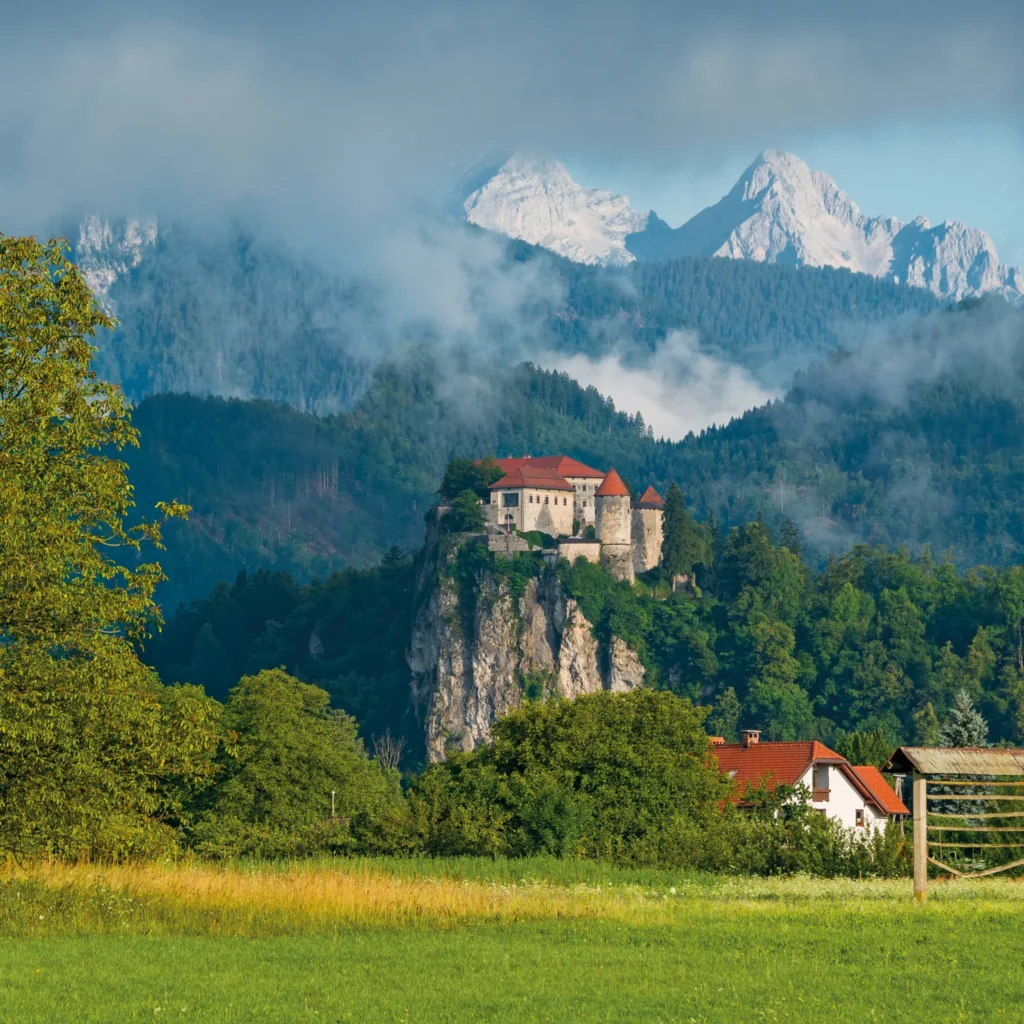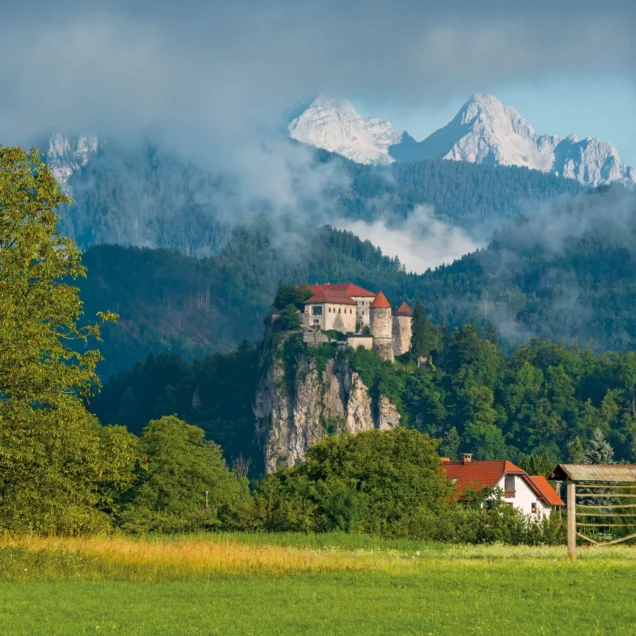

Set deep in the heart of Central Europe, our Slovenia adventure tours will show you a country blessed with natural beauty, from its mighty alpine peaks, stunning lakes to lush rolling farmlands, plains covered in sunflowers, grapevines strung across the fields and vast forests which cover 60% of the country. Bordered by Italy, Austria, Hungary, Croatia and the Adriatic Sea, Slovenia is seen by many as a miniature version of Europe.
Enjoy the capital Ljubljana on a Slovenia adventure tour which has a large student population and benefits from a young, fun vibe and popular culture, which provide a vibrant contrast to the Old Town in the historical centre. Highlights of the city include Križanke or French Revolution Square, Tivoli Park, Ljubljana City Museum, Ljubljana Castle (Ljubljanski Grad) on Castle Hill and the Viewing Tower in the castle courtyard for views across the Old Town. Ljubljana also features lovely promenades where you can enjoy the views from a café and take a stroll along the river, lined with willow trees. During a Slovenia adventure tour you can explore the picturesque town of Bled, about an hour from Ljubljana, set near an emerald green lake. Perched on a cliff high above the lake on a bluff is the Bled Castle, dramatically framed by the snow-capped peaks of the Julian Alps.

Slovenia was part of the Holy Roman Empire and then the Austro-Hungarian Empire until 1918, when the Slovenes joined the Serbs and Croats in forming a new multinational state, renamed Yugoslavia. After World War II, Slovenia became a republic of the renewed Yugoslavia, and although Communist, distanced itself from Moscow’s rule. The Slovenes succeeded in establishing their independence from Yugoslavia in 1991 after a short 10-day war. Historical ties to Western Europe, a strong economy, and a stable democracy have assisted in Slovenia’s transformation to a modern state. Slovenia acceded to both NATO and the EU in the spring of 2004.
Slovenia is wedged between Austria and Croatia. Often refered to as a microcosim of European geography as a whole, the geography varies from a short coastal strip on the Adriatic, an alpine mountain region adjacent to Italy and Austria and mixed mountains and valleys with numerous rivers to the east. Slovenia experiences a Mediterranean climate on the coast and a continental climate with mild to hot summers and cold winters in the plateaus and valleys to the east.
Our tours mostly operate from late spring (April/May) to early Autumn (in Eastern Europe) when the weather is generally at its best. Temperatures will vary but will still be cool in April/May and again in October. The warmest months tend to be July/August. The further south you are the higher the average temperatures. You can expect snow from December to late March.
Visit www.worldclimate.com to get an idea of what the weather will be like on your tour.
Many nationalities (including citizens of the UK, Australia, Canada, the US and most of continental Europe) do not need a visa to enter Slovenia. However, visitors must hold an onward ticket, all documents required for their next destination and sufficient funds. If your nationality is not listed please consult your nearest Slovenian embassy or consulate before you travel.
Slovenia is in the euro zone. For up to date exchange rates with your own currency visit www.oanda.com or www.xe.com.
The easiest way to obtain money in Slovenia is to draw it out of an ATM (cash machine) on a credit or debit card (e.g. visa or cirrus). ATMs are widely available throughout Eastern Europe and credit cards are accepted in many restaurants and shops. Another option is to bring cash in euros but we advise against bringing all your money in this form, in case of theft.
In a restaurant, round up the bill unless a service charge has already been added or the service was not up to standard. You should also round up bar bills and taxi fares. In Slovenia tipping is not compulsory, but a 10% gratuity in restaurants will always be appreciated.
Generally people find Eastern Europe to be safe and feel confident wandering alone during the day. However if you are unfamiliar with an area it is recommended that you exercise more caution at night and taxi taxis rather than walk, especially if you are a lone female traveller. In some cities bag snatching can occur so always keep a firm hand/eye on your personal items.
In Slovenia food is heavily based on fish, venison and the dumpling although popular everyday dishes also include cabbage, beans and potatoes. Every Slovenian region has its own various types of bread. Traditional dishes are best tried at an inn (gostilna).
Slovenia has been making wine since the time of the Romans, and it now produces many high quality varieties.
All drinks such as bottled water or soft drinks are at your own expense at all times and are fairly inexpensive. Alcoholic drinks vary in price, with wine and beer generally being the cheapest options. The legal drinking age is 18.
220-240 volts. European-style two-pin plugs are in use.
GMT/UTC +1. For other time differences please visit www.timeanddate.com
The 7 human-made Wonders of our World The ancients created the original list of the Seven Wonders of the World.…
Sometimes the chaos of a popular tourist city is enough to make any traveller run for the hills. Long queues,…
Wondering where the best places to visit in July are? Check out our favourite spots for your holiday in July…
We are passionate adventure travelers who want to share the world and our travel experiences with everyone…
This website uses cookies so that we can provide you with the best user experience possible. Cookie information is stored in your browser and performs functions such as recognising you when you return to our website and helping our team to understand which sections of the website you find most interesting and useful.
Strictly Necessary Cookie should be enabled at all times so that we can save your preferences for cookie settings.
If you disable this cookie, we will not be able to save your preferences. This means that every time you visit this website you will need to enable or disable cookies again.
